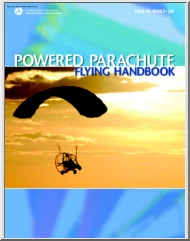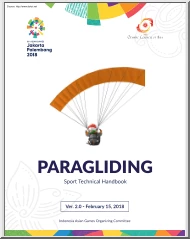Datasheet
Year, pagecount:2016, 8 page(s)
Language:English
Downloads:3
Uploaded:January 21, 2019
Size:3 MB
Institution:
-
Comments:
Free.Aero magazine
Attachment:-
Download in PDF:Please log in!
Comments
No comments yet. You can be the first!Most popular documents in this category
Content extract
free.aero Source: http://www.doksinet MON PREMIER. the #first. ISSN 2267-1307 Photo: Alexis Buisson /Albarsark-https://www.facebookcom/Albarsark WORLDWIDE PARAGLIDING AND PARAMOTORING MAGAZINE. FOR FREE Source: http://www.doksinet THE FIRST. TEST ADVANCE EPSILON 7 60 | @FreeAeroMag www.freeaero Source: http://www.doksinet THE FIRST. The Advance Epsilon 7 has been on the market for two years. It is very versatile with both paragliders and paramotors. Is this middle of the EN B range a good first wing? Advance Advance have taken their time bringing out the Epsilon 7, and a lot of R&D went into it. That’s why, two years after it was launched, it still isn’t out of date. The Swiss manufacturer is used to models with a long life span. The Alpha 5 is, and remains, an almost mythical EN A beginner wing, that pilots can keep (almost) for all their career. It is as good for free flying as with a motor. The Epsilon 7 is the model above, placed right in the middle of EN B
for free flying; a wing which is very versatile and even more unlikely to go out of fashion. The versatility of the Epsilon 7 is valuable whether free flying or with a motor. The motorized version differs from the free flying one by having another pair of risers as well as, depending on the size, 2, or even 4, C lines which are thicker. An Epsilon 7 ‘pure free flying’ can be converted. As for all wings of this type, in free flying only the foot accelerator is used, and with the motor only the trimmers. The Epsilon 7 is 1.2 kg lighter than the Epsilon 6. At 52 kg, it still isn’t a wing especially for hike and fly, but this decrease in weight improves, amongst other things, take off, especially with a motor. The lighter the wing, the easier it goes up, which is logical. We also know that a lighter wing is generally better behaved in the air because it has less energy, to dive for example. 61 | www.freeaero Photo: Thomas ulrich Source: http://www.doksinet THE FIRST. TAKING OFF
The wing comes up straight and reliably, whether free flying or with a motor. It doesn’t jump into the air like a spring; instead its behaviour at take-off is uniform which makes it easy. It keeps its course whilst gathering momentum and loads up rapidly, a good feature, especially with a motor. IN FLIGHT In a straight line, it flies as if on rails and is very comfortable. As far as manoeuvrability is concerned, the opinions of the test pilots differ, but it is primarily a question of wing loading. In the top part of the weight range the wing is very manoeuvrable and precise, thus always the case with a motor. A positive point for a wing is a combination of good stability and good manoeuvrability when going into a turn. In thermals, it is very efficient. Cédric Nieddu from Certika even claimed ‘it will be difficult to find better than that’. 62 | @FreeAeroMag www.freeaero Source: http://www.doksinet THE FIRST. The Epsilon 7 motorised version with the same wing. The only
difference: Two thicker C lines and trimmers on the risers. The trimmers and the foot accelerator are not used at the same time. One or the other should be operated depending on whether it is being used for free flying or with a motor. 63 | www.freeaero Photo: Thomas ulrich Source: http://www.doksinet THE FIRST. In any case, it doesn’t produce any nasty surprises in turbulent air. It is one of the most accessible wings in the middle of the EN B range and could even be suitable for a good student coming out of school. As for speed, with 37 km/h trim and 50 km/h accelerated, we can confirm the manufacturer’s figures to the nearest km/h. With a paramotor, if the pilot wants to stick with hybrid free flying/motor wings, excluding reflex wings, it’s got a very reasonable potential speed. WINGOVERS AND SPIRALS It is possible, despite its initial stability, to go quickly into a nice wingover, which the pilot can greatly increase by finding a good rhythm. Nevertheless, there is a
limit somewhere, above which the Epsilon 7 doesn’t want to go without being forced – all the better. It remains very manoeuvrable within reasonable limits. For spirals, it goes into them easily and can reach 14 m/s after two turns. 64 | @FreeAeroMag www.freeaero Source: http://www.doksinet THE FIRST. ADVANCE : EPSILON 7 MANUFACTURER INFO Manufacturer : ADVANCE Web : http://www.advancech/fr Size 26 28 30 Flat surface (m ) 19.3 21.8 23.5 25.2 20.4 22.30 24.46 27.32 All up weight (kg) 60-80 75-95 85-110 100-130 Weight of the wing 4.65 5.1 5.45 5.75 Flat aspect ratio 5.15 5.15 5.15 5.15 Trim speed ((km/h) 38+/-2 38+/-2 38+/-2 38+/-2 Max speed 51+/-2 51+/-2 51+/-2 51+/-2 Mini sink ratei Glide ratio Certification 65 | 23 Projected surface (m2) 2 1.15 1.15 1.15 1.15 8.4 +/- 01 8.4 +/- 01 8.4 +/- 01 8.4 +/- 01 B B B B @FreeAeroMag www.freeaero Photo: Thomas ulrich Source: http://www.doksinet THE FIRST. To exit, by weight
shifting to the outside, it sorts itself out. Watch Cédric Nieddu explain the details in the video. It also shows that this wing is equally gentle coming out of a spin. CONCLUSION Its stability, its calm in turbulence as well as its pretty good behaviour during an incident could permit the Epsilon 7 to be classed at the beginning of the B category where it would correspond to a talented pilot coming out of school. But as it is fairly high performance, typical of a well made middle of the EN B range, it will perhaps be a first ‘real’ wing for a pilot who has done a certain number of flights on an entry level paraglider. These flights could have been done on wings loaned by the school or an older EN A bought second hand. 66 | @FreeAeroMag www.freeaero
for free flying; a wing which is very versatile and even more unlikely to go out of fashion. The versatility of the Epsilon 7 is valuable whether free flying or with a motor. The motorized version differs from the free flying one by having another pair of risers as well as, depending on the size, 2, or even 4, C lines which are thicker. An Epsilon 7 ‘pure free flying’ can be converted. As for all wings of this type, in free flying only the foot accelerator is used, and with the motor only the trimmers. The Epsilon 7 is 1.2 kg lighter than the Epsilon 6. At 52 kg, it still isn’t a wing especially for hike and fly, but this decrease in weight improves, amongst other things, take off, especially with a motor. The lighter the wing, the easier it goes up, which is logical. We also know that a lighter wing is generally better behaved in the air because it has less energy, to dive for example. 61 | www.freeaero Photo: Thomas ulrich Source: http://www.doksinet THE FIRST. TAKING OFF
The wing comes up straight and reliably, whether free flying or with a motor. It doesn’t jump into the air like a spring; instead its behaviour at take-off is uniform which makes it easy. It keeps its course whilst gathering momentum and loads up rapidly, a good feature, especially with a motor. IN FLIGHT In a straight line, it flies as if on rails and is very comfortable. As far as manoeuvrability is concerned, the opinions of the test pilots differ, but it is primarily a question of wing loading. In the top part of the weight range the wing is very manoeuvrable and precise, thus always the case with a motor. A positive point for a wing is a combination of good stability and good manoeuvrability when going into a turn. In thermals, it is very efficient. Cédric Nieddu from Certika even claimed ‘it will be difficult to find better than that’. 62 | @FreeAeroMag www.freeaero Source: http://www.doksinet THE FIRST. The Epsilon 7 motorised version with the same wing. The only
difference: Two thicker C lines and trimmers on the risers. The trimmers and the foot accelerator are not used at the same time. One or the other should be operated depending on whether it is being used for free flying or with a motor. 63 | www.freeaero Photo: Thomas ulrich Source: http://www.doksinet THE FIRST. In any case, it doesn’t produce any nasty surprises in turbulent air. It is one of the most accessible wings in the middle of the EN B range and could even be suitable for a good student coming out of school. As for speed, with 37 km/h trim and 50 km/h accelerated, we can confirm the manufacturer’s figures to the nearest km/h. With a paramotor, if the pilot wants to stick with hybrid free flying/motor wings, excluding reflex wings, it’s got a very reasonable potential speed. WINGOVERS AND SPIRALS It is possible, despite its initial stability, to go quickly into a nice wingover, which the pilot can greatly increase by finding a good rhythm. Nevertheless, there is a
limit somewhere, above which the Epsilon 7 doesn’t want to go without being forced – all the better. It remains very manoeuvrable within reasonable limits. For spirals, it goes into them easily and can reach 14 m/s after two turns. 64 | @FreeAeroMag www.freeaero Source: http://www.doksinet THE FIRST. ADVANCE : EPSILON 7 MANUFACTURER INFO Manufacturer : ADVANCE Web : http://www.advancech/fr Size 26 28 30 Flat surface (m ) 19.3 21.8 23.5 25.2 20.4 22.30 24.46 27.32 All up weight (kg) 60-80 75-95 85-110 100-130 Weight of the wing 4.65 5.1 5.45 5.75 Flat aspect ratio 5.15 5.15 5.15 5.15 Trim speed ((km/h) 38+/-2 38+/-2 38+/-2 38+/-2 Max speed 51+/-2 51+/-2 51+/-2 51+/-2 Mini sink ratei Glide ratio Certification 65 | 23 Projected surface (m2) 2 1.15 1.15 1.15 1.15 8.4 +/- 01 8.4 +/- 01 8.4 +/- 01 8.4 +/- 01 B B B B @FreeAeroMag www.freeaero Photo: Thomas ulrich Source: http://www.doksinet THE FIRST. To exit, by weight
shifting to the outside, it sorts itself out. Watch Cédric Nieddu explain the details in the video. It also shows that this wing is equally gentle coming out of a spin. CONCLUSION Its stability, its calm in turbulence as well as its pretty good behaviour during an incident could permit the Epsilon 7 to be classed at the beginning of the B category where it would correspond to a talented pilot coming out of school. But as it is fairly high performance, typical of a well made middle of the EN B range, it will perhaps be a first ‘real’ wing for a pilot who has done a certain number of flights on an entry level paraglider. These flights could have been done on wings loaned by the school or an older EN A bought second hand. 66 | @FreeAeroMag www.freeaero





